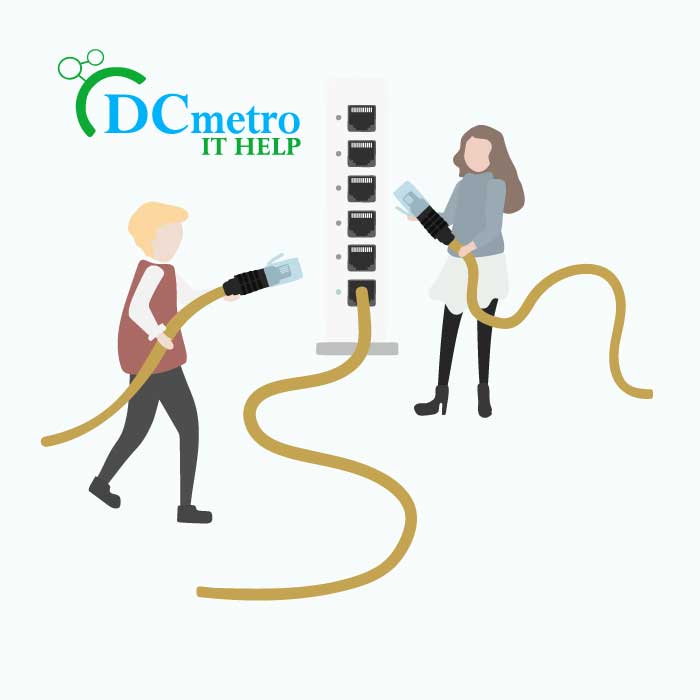In today’s fast-paced and interconnected world, the need for efficient and reliable data communication has become increasingly vital. Whether it’s in a residential or commercial setting, the importance of structured low voltage cable systems cannot be overstated. These systems provide the backbone for the transmission of data, voice, and multimedia content, facilitating seamless connectivity and organization. In this article, we will delve into the world of structured low voltage cable systems, exploring their benefits, components, and applications.
Contact us 202-810-7755 today to learn more about Structured Low Voltage Cable Systems. Please contact us for Structured Low Voltage Cable Systems for your business or if you have any questions or concerns.
DC Metro IT Help
The Basics of Structured Low Voltage Cable Systems:
Structured low voltage cable systems refer to a comprehensive framework of cables, connectors, and distribution components designed to support various information and communication technologies. They are commonly used for networking purposes, enabling the transfer of data across different devices and systems. These systems are characterized by their organization, flexibility, and scalability, making them suitable for both small-scale residential setups and large-scale enterprise networks.
Key Components of Structured Low Voltage Cable Systems:
- Cables: Structured low voltage cable systems typically employ different types of cables, including twisted-pair copper cables (such as Category 5e, 6, and 6a) and fiber optic cables. Twisted-pair cables are commonly used for shorter distances, while fiber optic cables offer higher bandwidth and are ideal for long-distance transmissions.
- Patch Panels: Patch panels serve as the central connection points within structured low voltage cable systems. They allow for the termination of cables from various locations, facilitating easy management and reconfiguration. Patch panels provide a neat and organized solution for routing cables to different devices, such as computers, telephones, or audio/video equipment.
- Keystone Jacks and Connectors: Keystone jacks and connectors provide the interface between the cables and the devices. They come in different types, such as RJ45 jacks for Ethernet connections or coaxial connectors for video applications. Keystone jacks and connectors offer flexibility as they can be easily snapped into patch panels, wall plates, or surface-mounted boxes.
Benefits and Applications:
- Enhanced Connectivity: Structured low voltage cable systems enable seamless connectivity between devices within a network. Whether it’s sharing data between computers, streaming high-definition content, or conducting video conferences, these systems ensure reliable and efficient data transmission.
- Improved Organization and Flexibility: The structured nature of these cable systems contributes to better organization and management of network infrastructure. With clearly labeled and organized patch panels and cabling, technicians can quickly identify and troubleshoot any issues that may arise. Moreover, the modular nature of these systems allows for easy additions, modifications, and expansions, ensuring scalability as network requirements evolve.
- Future-Proofing Technology: Structured low voltage cable systems are designed to support emerging technologies and higher data transmission speeds. By investing in these systems, individuals and organizations can future-proof their infrastructure, avoiding the need for extensive rewiring or upgrades when newer technologies emerge.
- Versatility in Applications: Structured low voltage cable systems find applications in various settings, including residential, commercial, and industrial environments. From homes and small offices to large corporate buildings, data centers, and educational institutions, these systems provide the connectivity and organization needed to support a wide range of applications.
Structured low voltage cable systems are the backbone of modern communication infrastructure. By integrating an organized and scalable cabling system, individuals and organizations can enjoy enhanced connectivity, flexibility, and efficiency in their networks. With their ability to accommodate evolving technologies and applications, structured low voltage cable systems offer a reliable solution for meeting the growing demands of data transmission. As the world becomes increasingly interconnected, investing in these systems becomes imperative for a seamless and robust network infrastructure.



1 Comment
Zoom Social
June 25, 2023Greetings! Very helpful advice within this article! Its the little changes that will make the greatest changes. Thanks for sharing!